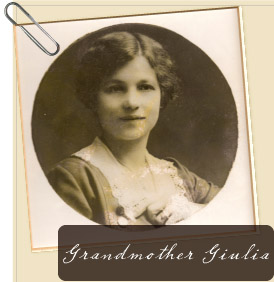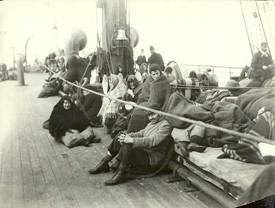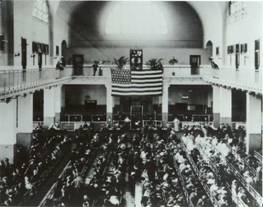Porta Mangiare

OVER A CENTURY AGO, WAVES OF SOUTHERN EUROPEAN IMMIGRANTS CAME TO AMERICA, BRINGING WITH THEM STRONG TRADITIONS AND WONDERFUL REGIONAL FOODS.
The Recipes of Porta Mangiare Foods are all derived from Grandmother Giulia (pronounced "Julia") who immigrated to America in the late 1800s. She was part of a wave of southern European Immigrants who came to America over 100 years ago in search of a better way of life.
During the century between 1876 and 1976, the U.S. was the largest single recipien t of Italian immigrants in the world. From 1880 to 1900, southern Italians became the predominant Italian immigrant and stayed that way throughout the mass migration. After an almost unimaginable voyage in “steerage class”, they landed, along with all their worldly posessions, at Ellis Island in New York harbor. There they waited in long lines, and sometimes for days to be examined and evaluated for admittance into the United States.
t of Italian immigrants in the world. From 1880 to 1900, southern Italians became the predominant Italian immigrant and stayed that way throughout the mass migration. After an almost unimaginable voyage in “steerage class”, they landed, along with all their worldly posessions, at Ellis Island in New York harbor. There they waited in long lines, and sometimes for days to be examined and evaluated for admittance into the United States.
 Along with their rich culture and a tenacious desire for a better life, the immigrants brought with them the recipes and techniques that were used for hundreds of years in the villages that they left. They made these recipes, many just peasant dishes with a local flair, for their children growing up in the New World.
Along with their rich culture and a tenacious desire for a better life, the immigrants brought with them the recipes and techniques that were used for hundreds of years in the villages that they left. They made these recipes, many just peasant dishes with a local flair, for their children growing up in the New World.
But America’s melting pot wasn’t just cultural, it was culinary as well. Many of the old recipes and techniques have become lost along with that first generation of immigrants. There seemed to be a growing hole in people’s need for the flavors and aromas of their childhood.
Giulia’s History
In the late 1800s, at the age of 17, Giulia arrived at Ellis Island in New York Harbor as a newlywed. She settled nearby and raised a large family in an ethnic neighborhood where many Italians settled. Early on, life was good. Food was plentiful and purchased daily from street vendors and local butchers and bakers. Rarely did they have to leave the neighborhood to find things they needed.
During the depression, she took in borders to help make ends meet. Included with the rent was breakfast and dinner for the tenants. Grandmother Giulia spent her entire life in her kitchen, surrounded by recipes and aromas from her native Cosenza in Calabria, the "toe" of the boot of Italy.
Her meals were hearty and her recipes usually made huge quantities. These were the comfort foods, and while she never wrote the recipes down, you could find the same dishes on any block in the neighborhood back then; but not today. The adventuresome Immigrants of that era are gone, and with them many of their recipes and techniques.
As time goes by, more and more we are the last generation that knew first-hand these pioneers and the foods that they made. The goal of Porta Mangiare is to recreate and preserve the authentic recipes so that more people can experience what it must have been like sitting down to a family meal at the end of the 19th century.